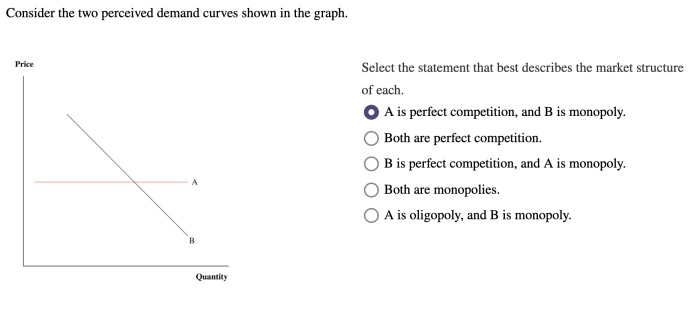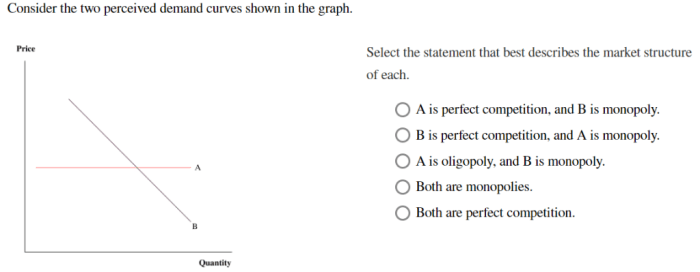Consider the two perceived demand curves shown in the graph. These curves represent the relationship between the price of a product and the quantity demanded by consumers. Perceived demand curves are important for businesses to understand because they can help them to make decisions about pricing, production, and marketing.
The factors that can influence perceived demand include consumer preferences, product attributes, and marketing efforts. Consumer preferences are the tastes and desires of consumers. Product attributes are the features and benefits of a product. Marketing efforts are the activities that businesses use to promote their products to consumers.
Perceived Demand Curves

Perceived demand curves represent consumers’ perceptions of the relationship between product price and quantity demanded. They differ from actual demand curves, which are based on observed market data. Perceived demand curves are influenced by various factors, including consumer preferences, product attributes, and marketing efforts.
Examples of perceived demand curves can be found in different industries. For instance, in the fashion industry, consumers may perceive a higher-priced item as being more luxurious and desirable, leading to a higher perceived demand at a given price compared to a lower-priced item.
Factors Influencing Perceived Demand
- Consumer Preferences:Consumers’ tastes and preferences can significantly influence perceived demand. For example, a product that aligns with prevailing trends or cultural values may have a higher perceived demand.
- Product Attributes:The physical and functional characteristics of a product can impact perceived demand. Features such as design, quality, and durability can influence consumers’ willingness to pay a higher price.
- Marketing Efforts:Marketing campaigns can shape consumers’ perceptions of a product and its value. Effective marketing strategies can create a positive image, increase brand awareness, and drive perceived demand.
Shifts in Perceived Demand, Consider the two perceived demand curves shown in the graph
Perceived demand curves can shift over time due to various factors. Some common reasons include:
| Type of Shift | Causes |
|---|---|
| Positive Shift | – Increased consumer preferences- Improved product attributes- Effective marketing campaigns |
| Negative Shift | – Changing consumer preferences- Declining product quality- Ineffective marketing |
Relationship Between Perceived and Actual Demand
Perceived demand curves can influence actual demand, but they may not always be perfectly aligned. Factors such as availability, income constraints, and market competition can affect the actual demand.
Implications for Businesses
Understanding perceived demand curves is crucial for businesses. By considering the factors that influence perceived demand, businesses can develop strategies to:
- Manage Consumer Perceptions:Businesses can use marketing and branding efforts to shape consumer perceptions and create a positive image for their products.
- Optimize Product Offerings:Businesses can design and improve products to meet consumer preferences and enhance perceived value.
- Monitor Market Trends:By tracking shifts in perceived demand, businesses can identify opportunities and adjust their strategies accordingly.
FAQ Compilation: Consider The Two Perceived Demand Curves Shown In The Graph
What is a perceived demand curve?
A perceived demand curve is a graphical representation of the relationship between the price of a product and the quantity demanded by consumers.
What factors can influence perceived demand?
The factors that can influence perceived demand include consumer preferences, product attributes, and marketing efforts.
How can businesses use perceived demand curves?
Businesses can use perceived demand curves to help them make decisions about pricing, production, and marketing.


